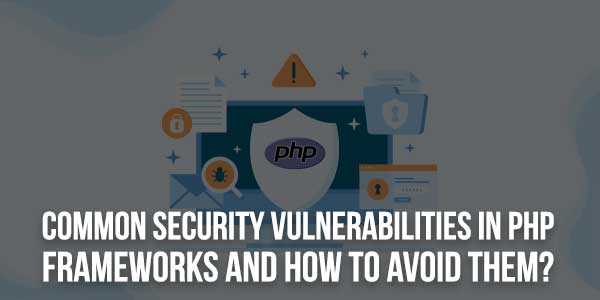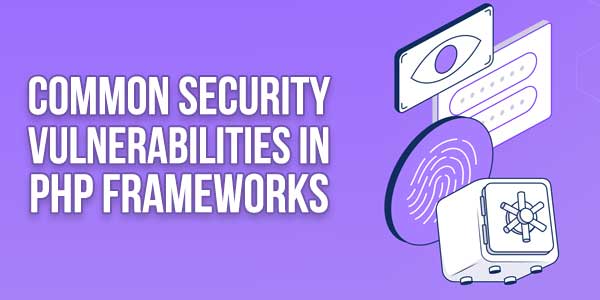
Today, hundreds of millions of websites are active on the internet, and so many of them have been created by some sort of web framework, the most common among which is the PHP framework. These frameworks simplify and speed up the website development process by automating common repetitive tasks like database interactions and form handling.
When it comes to frameworks, the most popular ones around the world are powered by PHP since it is the most popular programming language with a 77% market share. So you can say that PHP has become a de-facto or go-to language for websites and web applications. Now, there are a few reasons behind this popularity, including simplicity, cost-effectiveness, versatility, CMS compatibility, large community, extensions, etc.
But you may not want to think it’s all good with the PHP frameworks. One of the most significant downsides with the PHP frameworks is the security issues.
Security is one of the most integral aspects of any website or web application and should be kept a priority to ensure protection against any possible threats. Security measures like input validation and output sanitization can help with SQL injection and cross-site scripting (XSS) in PHP. Then there are authentication and authorization features like access control, user authentication, and session management that can help ensure that the sensitive data and information present on the website is only accessed by authorized personnel.
Although PHP wasn’t inherently designed with security issues, nowadays, the issues have led to the development of more vulnerable websites and web apps.
So in this blog, we’ll discuss the most common security vulnerabilities in the PHP frameworks and even advise you on how to prevent them.
Table of Contents
Common Security Vulnerabilities In PHP Frameworks:
As the term suggests, security vulnerabilities can leave the PHP website quite vulnerable to common threats like hackers, brute force attacks, etc. That can jeopardize the privacy of your users and customers (in the case of eCommerce websites). So it’s important to counter these vulnerabilities to ensure your website is of the highest quality in terms of security.
So let’s check out some of PHP frameworks’ most common security vulnerabilities.
SQL Injection:
In injection vulnerabilities, especially SQL injection, the hacker bluffs the server by entering an unsanitized SQL command in the database, which makes the SQL query return information that isn’t necessarily supposed to be exposed, including user details, customer data, passwords, database contents, and so on. This attack may even grant the hacker access to the whole website in a single shot.
How to prevent it?
Don’t worry, though; you can prevent SQL injections by being careful when accepting the user inputs, using prepared statements in your code (rather than simple text-based questions), and using parameterized queries.
Cross-Site Scripting (XSS):
Hackers use cross-site scripting to get access to the user’s cookies and steal passwords by injecting malicious JavaScript or HTML code into your website. They may even manage to get administrator-level access to your website and control it remotely.
Some of the best examples of XSS are seen on community forums and message boards. Suppose a community forum website doesn’t authenticate the messages sent by the users. In that case, a hacker may send out a malicious code script on the board, which causes the users (who are exposed to the code) to accidentally share their login credentials and much more sensitive info.
How to prevent it?
There are a few ways to prevent this security vulnerability:
- Enable an XSS filter through the XSS-protection header.
- Convert special characters into HTML entities by applying
htmlentities()andhtmlspecialchars(). - Use a PHP web application firewall (WAF).
- Third-party PHP libraries like PHP Anti-XSS, htmLawed, and HTML purifier can also help prevent XSS.
Follow these steps with your PHP code to prevent any risk of XSS attacks on your website or app.
Cross-Site Request Forgery (CSRF):
In this cyber attack, the hacker creates a legitimate-looking website or email that sends a request to another website on your behalf. The request may look legitimate if the user is already logged in to the targeted website, which may cause adverse actions like password change, fund transfer, or data deletion.
How to prevent it?
You can prevent cross-site request forgery through authentication tokens. It makes authorizing an action difficult since a new token is generated on every login.
File Inclusion Vulnerabilities:
There are two types of file inclusion attacks: Remote File Inclusion (RFI) & Local File Inclusion (LFI). In LFI attacks, the attacker can use the web application to retrieve files from the local file system of the web server, including configuration files, source code, and even password files. In RFI attacks, the attacker can include a remote file hosted on a different server, which can contain malicious code that can be executed on the web server.
This vulnerability may cause serious issues like data theft, system compromise, and unauthorized access to sensitive website data and user information.
How to prevent it?
To prevent file inclusion attacks, web applications limit access to sensitive files through proper file permissions and access controls, should validate and sanitize user input, and avoid using user input to construct file paths.
Session Hijacking:
In this security vulnerability, an attacker gains access to a user’s active session on a web app or website. That allows the attacker to impersonate the user and perform actions on their behalf, such as making purchases, changing passwords, or accessing sensitive information. Session hijacking can occur when an attacker intercepts or steals the user’s session ID, which is typically stored in a cookie or URL parameter.
How to prevent it?
To secure a PHP development from session hijacking, web apps can implement several security features like secure session management techniques, session data encryption, secure cookies, and SSL/TLS implementation. It helps encrypt the network traffic. You can also protect the website against session hijacking by avoiding public WiFi networks. Also, make sure to update the device with the latest security patches.
Although there are several other security issues with PHP frameworks, these ones are regarded as the most common ones. To secure your website against these issues, hire a professional PHP developer and implement the reinforcements on the code.
Everyone wants to keep their website secure from any kind of hacks or brute-force attacks. So next, we’ll see what you can do to ensure PHP framework security.

Best Ways To Secure The PHP Frameworks:
The security vulnerabilities mentioned earlier may seem quite intimidating since they expose the most vital data and information about your website or web app and cause adverse actions like password change, fund transfer, or data deletion.
But don’t worry. There are several ways to prevent your PHP frameworks and, in turn, your website or web app from these security issues.
So let’s discuss the best secure coding practices for PHP developers:
Input Validation And Sanitization:
You can start with validating and sanitizing all user inputs. That includes form data and URL parameters and prevents common attacks like SQL injection and cross-site scripting (XSS) attacks.
Input validation is a technique of checking and ensuring the user input is in the expected format and within acceptable limits. That helps with SQL injection prevention in PHP.
Sanitization helps remove any potentially malicious user inputs, including code or characters. That helps prevent attacks like cross-site scripting (XSS) due to unsanitized user inputs.
That can be achieved by using functions like ‘filter_input()’ and ‘htmlspecialchars()’.
Parameterized Queries:
Parameterized queries separate the SQL statement from the user input and use placeholders in the SQL statement where the input will be inserted. The database engine then takes care of escaping or sanitizing the user input before it is inserted into the query. It prevents an attacker from injecting malicious code into the SQL statement.
For example, instead of concatenating user input directly into a SQL query like this:
SELECT * FROM users WHERE username = '$username' AND password = '$password'
A parameterized query would use placeholders for the username and password like this:
SELECT * FROM users WHERE username = ? AND password = ?
The application would then bind the user input to the placeholders, and the database engine would take care of properly escaping or sanitizing the input before executing the query.
Secure Session Management:
Secure session management ensures that the user sessions are protected against unauthorized access or hijacking. A few of the best practices of session management are using secure session IDs, implementing session timeouts, using HTTP, setting cookie security settings, and using server-side session storage.
That helps prevent session hijacking attacks and protect user sessions from unauthorized access or tampering. It can be achieved by using secure sessions handling functions like session_regenerate_id() and session_set_cookie_params().
Escaping Output:
Escaping output is the process of encoding user-generated content to prevent attacks like XSS. This tactic is a crucial security measure for web applications that display comments, forum posts, or any other form of user-generated content. Its purpose is to encode special characters in the user input to prevent the browser from interpreting them as code.
In PHP frameworks, the output can be escaped using functions like htmlspecialchars() or by using templating engines that automatically escape output.
Using Secure Coding Practices:
One of the best ways to prevent security vulnerabilities in PHP frameworks is by using secure coding practices like implementing least privilege access, avoiding hard-coded passwords, and keeping software updated with security patches. It is also important to follow standard industry practices like the OWASP Top Ten, to ensure that all potential security risks are prevented.
A few of the prominent secure coding practices are:
- Avoid using hardcoded passwords: Store the passwords in a secure database or use a secure password storage mechanism like Argon2 or bcrypt.
- Implement least privilege access: Give users and processes only those privileges that are necessary for them to perform their tasks.
- Keep software up-to-date: Stay updated with the security patches and implement regular updates for every software used in your PHP site or app.
- Use secure file handling practices: Use secure sessions handling functions like
session_regenerate_id()andsession_set_cookie_params()for PHP session hijacking prevention. - Use secure encryption practices: Use secure encryption algorithms and key management practices to protect sensitive data.
These secure coding practices for PHP developers can help avert the risk of security vulnerabilities in their applications. It is crucial to keep updated with the latest security best practices and regularly perform a PHP vulnerability assessment of your code to ensure that it remains secure over time.
Tools For Detecting & Preventing Security Vulnerabilities In PHP:
By now, you know there is a possibility of security with PHP frameworks since they, along with the PHP language, are open-source. But don’t worry; there are several tools available on the internet that can help detect and prevent any security vulnerability quite effectively.
So let’s check out some of the prominent tools for vulnerability detection and prevention in PHP frameworks:
- OWASP Dependency-Check: This software composition analysis tool scans the PHP dependencies and generates a report of any known vulnerabilities.
- RIPS: This PHP security analysis tool uses static code analysis techniques to detect security issues like SQL injection, XSS, and code execution vulnerabilities in PHP code.
- Blackfire: Blackfire is a PHP profiling tool that goes through the PHP code to identify performance bottlenecks and security vulnerabilities like SQL injection and XSS vulnerabilities. It also detects and shows performance issues like excessive memory usage and slow database queries.
- Snyk: This vulnerability management tool can help scan PHP applications to detect vulnerabilities in code, dependencies, and configurations and even provides the best actions to fix them.
- PHP Security Audit: It is a static analysis tool to scan the PHP code for security issues like SQL injection, cross-site scripting (XSS), and file inclusion vulnerabilities.
- PHP CodeSniffer: It is a code analysis tool that can detect coding standards violations and security issues in a PHP code. You can even configure it to apply coding standards like PSR-1 and PSR-2. PHP CodeSniffer can also identify issues like missing input validation and sanitization.
These are just a few best tools to identify and rectify the security vulnerabilities in a PHP code and its dependencies, which help prevent attacks and improve the overall security of PHP frameworks and their applications.
Conclusion:
As we mentioned earlier, security is one of the most important aspects of any website or application. It won’t matter how good your website is; if it’s not secure, people won’t visit it out of privacy concerns.
Now since PHP and most of its frameworks are open-source, there are bound to be some security vulnerabilities. So in this blog, we have tried to explain these issues, primarily among which are SQL injection, XSS (cross-site scripting) attacks, CSRF (cross-site request forgery), session hijacking, and file inclusion vulnerabilities.
But you can prevent it through some simple implementations like input validation and sanitization, parameterized queries, secure session management, escaping output, and using secure coding practices.
So implement them to your PHP frameworks and codes, keep the software updated with security patches, and introduce regular updates to avert any risk of security vulnerabilities.
If you think you are not skilled enough to secure your PHP website or web app, hire a PHP development company. They will help implement the best security practices on your code and framework to protect the website against any possible security vulnerabilities.

 About the Author:
About the Author:
















Be the first to write a comment.